SRI LANKA

Sri Lanka – formerly known as Ceylon – is a tear-drop shaped island nation in the Indian Ocean off the southeast tip of India.
Sri Lanka is one of the oldest settlements on earth. Paleolithic era settlements have been found in several sites, and there is early written reference to it in the Indian epic Ramayana. It is also believed that Galle on Sri Lanka is the biblical King Solomon’s Tarshish. The earliest inhabitants were probably the Veddahs which settled on Sri Lanka more than 3,000 years ago.
Ancient Sri Lanka was ruled by monarchs of the Sinha Royal Dynasty. There were occasional invasions by various south Indian dynasties, but the Sinha Royal Dynasty ruled for more than 2,000 years.
Buddhism arrived from India in the 3rd century BC by Venerable Mahinda – the son of Emperor Ashoka. It spread widely and quickly.
A Portuguese colonial mission arrived in 1505 and ruled the coastal areas. The Portuguese called the island Ceilao, and that was the origin of the name Ceylon which is what the island was called until 1978.
In the 17th century, the Sri Lankans sought help from the Dutch to oust the Portuguese. The Dutch obliged, and after ousting the Portuguese, the Dutch ruled the coastal areas. During these colonial periods, the interior regions were not colonized. They remained under Sri Lankan control with a capital at Kandy.
The British East India Company defeated the Dutch in 1796, and they took over control of the coastal areas. They annexed Kandy in 1815, and the island was unified under British rule.
The British established plantations to grow cinnamon, sugar, coffee, indigo, tea, and rubber. They imported workers fromTamil Nadu in India (the ‘plantation Tamils’) to work these plantations. They established a capital in Colombo, and they introduced Western-style culture to the island.
The independence movement began in the 1930s. The movement slowed somewhat during World War II when Sri Lanka became an important allied military base, but popular pressure for independence increased after the war. Sri Lanka was granted independence on February 4, 1948 while maintaining a good relationship with the British.
From 1956 to 1971, Sri Lanka moved toward links with the communist bloc. In 1971, there was a Marxist insurrection that was quickly suppressed with international support. In 1972, a new constitution was adopted, Sri Lanka became a republic, and they became a member of the Commonwealth of Nations.
The independence movement was mostly a Sinhalese movement. They tried to remodel Sri Lanka as a Sinhalese nation-state with Sinhala as the national language – a language not spoken by most Tamils. The Sinhalese tried to make Buddhism the national religion; however, most Tamils are Hindu or Muslim. There were also affirmative action policies in favor of the Sinhalese. The Tamils perceived these actions as deliberate marginalization, and they demanded a separate nation-state in the north and east parts of the island.
Civil war began in 1983 with the Liberation Tigers of Tamil Eelam (LLTE) – or Tamil Tigers – fighting the Sri Lankan government. This war raged until May 19, 2009. Wounds remain fresh.
Sri Lanka’s name is actually the Democratic Socialist Republic of Sri Lanka.
Sri Lanka is separated from India by the Gulf of Mannar and Palk Strait. It is comprised of 25,332 square miles including flat coastal plains and interior mountains. The highest point on the island is Mount Pidurutalagala at 8,281 feet. It has a tropical monsoon climate.
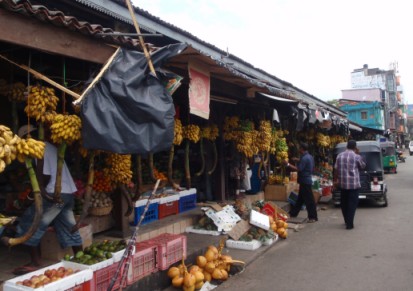
Fruit market on main road in Galle
Sri Lanka’s population is slightly more than 20 million. Although a caste system still exists, it is not rigidly adhered to as in other parts of the subcontinent. Sri Lankans are 82% Sinhalese, 14% Tamil, and 4% other. There are two national languages – Sinhala and Tamil – and English is spoken by about 10%. Sinhala has its own script – unique to Sri Lanka only. They are 69% Buddhist – mostly Therevada Buddhism. There are also 15% Hindus, 8% Muslims (mostly Sunni), and 8% Christians. Nine years of compulsory education are required, and it is provided without cost. Sri Lankans enjoy a 92% literacy rate, and 83% have completed a secondary education. Health care is provided without cost.
Sri Lanka has been a democracy with universal suffrage since 1931. The national government is a mixture of the presidential system and parliamentary system. The president is the head of state, and the prime minister is the president’s deputy.
Sri Lanka had a plantation economy in the 19th and 20th century mostly reliant on cinnamon, rubber, and tea. The colonial plantations were dismantled in the 1970s, and industries were nationalized. Privatization returned and deregulation characterized the 1980s, and they moved swiftly toward an industrialized economy with textiles and garment manufacturing leading the way. In 1970, plantation crops accounted for 93% of exports, but by 2005 it had fallen to 17%. Nonetheless, Sri Lanka still exports considerable tea, coffee, coconut, rubber, and cinnamon.
Sri Lankans have the highest income in south Asia at $1,972 per person; however, 14% still live on less than $1.25 per day. The Sri Lankan currency is the Sri Lankan rupee (LKR), and the current exchange is approximately 113 rupees per one US dollar.
Sri Lanka was in the path or the tsunami of December 26, 2004 that wreaked havoc in much of coastal Asia. Fifty thousand Sri Lankans were killed by the tsunami. The landscape is still scarred by remnants of this disaster.
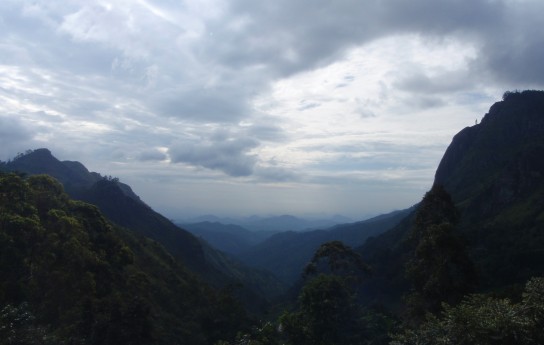
Beautiful Ella Gap
Our introduction to Sri Lanka got off to a rough start. We had to clear in with four government agencies – navy, customs, immigration, and health – and all four requested bribes. We had hired the mandatory agent, and we paid the agent $200 USD for his ‘services’, but the presence of the agent did not deter the requests. We did give a pair of inexpensive sunglasses (specifically requested) to the navy officer and a bottle of Thai rum to the customs officer, but we gave nothing to the immigration or health officers. We found the immigration officer particularly obnoxious (we were later told that he was also drunk), and we laughed at the health officer when he asked for cigarettes. This introduction would be a telling preview of experiences to come in Sri Lanka.
We were told to stern tie to a plastic pontoon well inside the harbor. This pontoon definitely lacks the strength to secure the ten boats that were tied to it. This harbor experiences moderate surge, and the pontoon would assume various serpentine shapes as boats surged fore and aft. We were fortunate that our bow anchor held; others were less fortunate.
The harbor is also very dirty. It is used for commercial vessels as well as yachts, and the commercial vessels seem to contribute a disproportionate amount to the harbor pollution. There is usually a surface sheen from fuel spills, and the loading/unloading of some vessels has created a large amount of airborne dust and dirt. Ships carrying concrete (for a new harbor being built on the south shore) are unloaded day and night about 50 yards upwind from our boat. What a mess!!
There is neither water nor electricity supplied to the pontoon, so visiting boats must either carry water to their boats (particularly difficult on the unstable pontoon) or run their watermakers. Boats must generate their own electricity.
Fuel to run generators must be hand carried by jerry cans – again, difficult on the unstable pontoon. There is no other option.
At first, we were not adequately comfortable tied to this pontoon to consider traveling inland which would require leaving Passage unattended for a few days. But after being here for ten days, we felt safe in leaving her briefly. We got lucky, and she survived our absence just fine.

Our road/train travel
We needed to ‘hit the ground running’ to get a replacement radar and GPS ordered, so we quickly met up with a recommended driver and found an internet source. We quickly decided on which models we wanted to order, and we placed the orders within 48 hours of arriving. Now we had time to explore Galle.
Galle is the fourth largest city in Sri Lanka, but it feels much smaller. It is an easy stroll to walk from one end of town to the other. There are many shops, and roadside fish sellers are also abundant – not surprising considering the number of fishing boats that are on the water each night.
Shopping is not easy. Drivers receive a ‘kickback’ when they take you somewhere, so they take you to places where they have existing ‘arrangements’, and these may not be the best source on island. Vendors also charge tourists an exorbitantly inflated price for all goods. One must be a cautious shopper.
We had experienced fuel problems shortly before arriving Sri Lanka, and we needed to have our injector pump rebuilt. Our driver took us to a dismal dirty shop that was not adequately equipped to service this pump even though there was an excellent pump service business nearby. We found that business on our own.
We visited a handicrafts outlet that had some interesting items for sale, but the hard-sell approach turned us off, and we left without buying anything. We also visited the old Dutch fort, and we were surprised by its large size. It is still a formidable rampart facing the sea, but now one finds shops and guesthouses inside the walls. A very nice place to pass some time.
So our radar and AIS were ordered, we got the watermaker working ok again, and we got the injector pump rebuilt (done in less than two hours for less than $100 USD). After ten days on the plastic pontoon we felt safe in leaving for a few days while we waited for our shipments, so we traveled inland and upcountry.
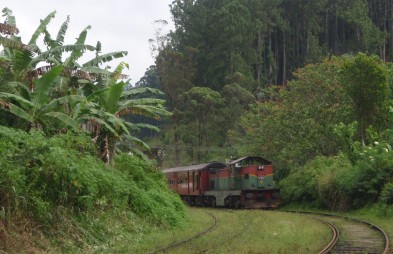
An old but charming train
We will not drive anywhere on the Asian sub-continent – India, Nepal, or Sri Lanka. So we hired a driver to take us around the southern half of the island. We did not have any recommendations, so we took ‘pot luck’, and we got lucky in hiring a very nice man and good driver – Hema.
We started in Galle which is in the southwest part of the island. From Galle, we made a counterclockwise loop.
We drove south and east along the coast, and we passed through some interesting villages. We saw the stilt fishermen – men who tie themselves to sticks stuck in the sand in the surf and fish from these little perches. We went through a traditional curd village – a village that supports itself solely by making curd (plain yogurt) from water buffalo milk.R
We went through Hambantota – the president’s home town. There is a tremendous amount of new construction occurring in this town including an international convention center and what will be the country’s largest harbor. Unfortunately this construction is destroying much habitat of wild elephants, and inevitable conflict between humans and elephants is increasing. Efforts are underway to relocate these elephants, but apparently the relocation is not happening fast enough for the farmers or the elephants.
We headed north and stopped for tea at a local shop – very local. We tried wood apples for the first time. Bud thought they were ok, but Nita thought they were terrible.
We started climbing in altitude as we headed for the southern hill country. This was once an integral part of the Kandyan Kingdom, but what remains is a creation of the British colonial period. The tea plantations changed the economics of Sri Lanka forever.
We stopped for a very good local lunch just outside of Ella – elevation just under 3,500 feet. Ella is a village that exists on tourism. Tourists go there mostly to take in the spectacular views. There are waterfalls, hiking trails, caves, and the gap – the Ella Gap. We stopped to look at the 300’ Rawana Ella Falls – called Bambaragama Falls by locals. The touts and conmen were very annoying. We did not hike to the Rawana Ella Cave, but many believe this cave is where Sita (of the Ramayana) was held captive. But we did marvel at the Ella Gap. This is a view of a valley that is indescribably beautiful. It was cloudy when we were there, so we could not see its full scope, but what we saw was magnificent. Neither of us are strangers to mountain views, and we were both taken by this one.
Unfortunately, the best hotel in Ella with the best view of the gap was full – as were the next three we tried. We found a room on our fifth try at the Country Comfort Inn, and it was overpriced and without a view. Oh well…
In the morning we returned for one last view of the gap. Unfortunately it was still cloudy.
We boarded a train for a few hours’ ride further up the mountains to Nuwara Eliya. The train was old and noisy and cost 110 LKR – just under $1 USD. More breathtaking scenery. We went through hills and valleys, terraced farm land, along precipitous ridges, through forest, and next to waterfalls. We reached the 6,226 summit at Pattipola just before arriving at the Nanu Oya station about 3 miles outside Nuwara Eliya.
Nuwara Eliya is Sri Lanka’s highest town, and it sits in the shadow of Sri Lanka’s highest peak – Pidurutalagala. It was established by the British in the early 19th century. Coffee plantations were started in the 1830s, but they were an eventual failure. Vegetables were planted starting in the 1840s, and they are still productive. But the motherlode came from tea planting which started in the 1860s.
The British legacy lives on in Nuwara Eliya, and it is often called ‘Little England’. It is dotted with old tea plantation estates developed by the British. It is surrounded by countless miles of tea. We went to the Blue Field Tea Factory hoping to learn a bit about tea production, but the ‘tour’ was a dud. As we headed down the hill, we stopped at another waterfall – the Ramboda Waterfall – which was actually a series of falls. Sri Lanka generates much hydroelectric power from these falls and lakes. We also saw monkeys along this drive.
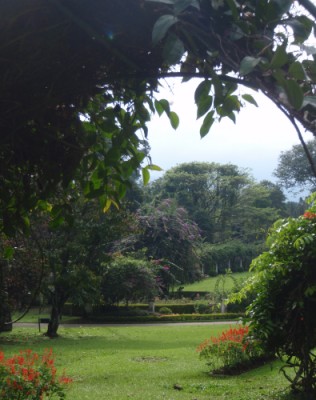
Kandy’s botanical gardens
We drove through the core of Sri Lanka’s spice industry and stopped at the Surathura Spice and Herbal Garden. It was an odd experience. The owner is an herbal physician, and they make some rather outrageous claims about the powers of the spices and herbs they grow. We did, however, buy a tasty (albeit overpriced) herbal tea there.
Then we drove on to Kandy. Kandy is at the center of the island, and it is Sri Lanka’s 2nd largest city after Colombo. Kandy has a history of independence during the Portuguese and Dutch colonization, but the British took over sovereignty in 1815. The city is arranged around a manmade lake commonly known as Kandy Lake or Kiri Muhuda which means milk sea. Kandy is the home Sri Lanka’s most important religious shrine – the Temple of the Tooth. We opted out of visiting the temple.
We spent only one night in Kandy. We went to a cultural dance exhibition at the Kandyan Art Associations Hall, and we enjoyed it even though it was quite touristy. We usually enjoy watching cultural dancing as a window to how a cultural perceives its past. It was interesting.
We experienced a bait-and-switch at the Kandy View Hotel where we stayed. The hotel ‘made a mistake’, and the standard room we requested was not available – only their ‘luxury suite’. But, of course, we were expected to pay for their mistake (this is so typical of Sri Lanka). It was late, we were tired, and it was a small amount, so we did it. And our ‘luxury suite’ was a bit of a dump. (Sri Lanka hotel standards are quite low.)
The next morning we went to the botanical gardens. They were a nice respite in a busy city. We wanted out of the city and back in the mountains.
The plan was that we would drive north to Sigiriya which is a monolith rock that served as a citadel in times past. We stopped for lunch along the way, and we were overwhelmed by the numbers of tourists. We wanted off the tourist trail, and we did not want to climb around Sigiriya in the rain, so we talked with our driver and made a change of plans. We headed for the Pinnewala Elephant Orphanage.
The elephant orphanage was started in 1975 to care for five orphaned baby elephants. It grew to eighty and currently has 70. Its residents are adults and babies with one or two babies born each year. The adults have histories of being rescued – often injured. One adult female – Sama – had a foot blown off from a landmine about five years ago. She gets around well on three feet. The oldest resident is a 66 year old male – Raja – who is also blind.
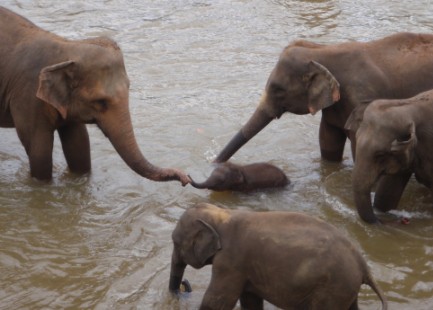
Sixty elephants including one very cute baby
We checked in to the Elephant Park Hotel which is across the street from the orphanage and on the Ma Oya River where they bring the elephants twice daily. Our room opened over the river – very nice. There was a swarm of large fruit bats at sunset. The following morning, we spent a few hours watching the elephants enjoying the river. A very nice experience for elephant lovers like us.
As we traveled about, we were often asked, “What is your country?”. We received a variety of responses when we replied, “America”. We did not experience any personal animosity against us, but we did learn that many Sri Lankans do not like the American government. We have experienced this before, and we always try to find out why. We were very surprised to learn that a common belief in Sri Lanka is that the American government aided the Tamil Tigers during the decades of civil war. There is much bitterness toward the American government because of that belief.
But it was finally time to head home, and we had a six to seven hour drive ahead of us. We drove through small villages and medium sized towns. There was so much to see. We stopped for a local lunch that we thoroughly enjoyed – no more tourist food. And we stopped for a cup of tea a few hours later when we were feeling a bit road weary.
On our lengthy drive, we never went more than 50 kph – the equivalent of 30 mph. We drove a lot of back roads looking for rural life. We saw lots of scenery and wildlife including large monitor lizards, monkeys, birds, and bats. We got home just before dark, and we were very relieved to find Passage sitting just as we had left her.
When we returned, our AIS had been in Sri Lanka in customs for eight days, but it had still not been delivered. Our radar had been in Sri Lanka and in customs for two days, but it had still not been delivered. We had advised our agent of these pending deliveries to his office, but to no avail. He explained a rather ridiculous process that arriving parcels endure, and we had no idea when we would actually receive these items. We paid a lot of money to have these things expedited here only to get mired in the customs shuffle.
Our AIS spent two weeks in customs, and our radar spent one week. We paid our agent hundreds of dollars to get them out of customs and to us. They were delivered at 2230 at night. But they are installed and working, and we are out of here. We are now headed for the northern Maldive Islands where we will recharge our spirits with some diving.
Sail with us from Sri Lanka to the Maldives or jump ahead to the Maldives or Return to our Destinations page.